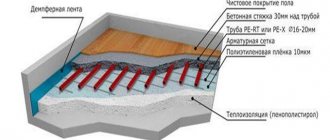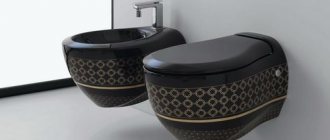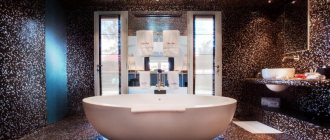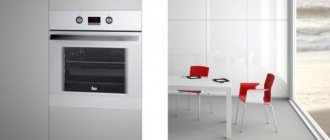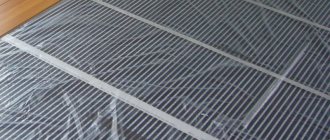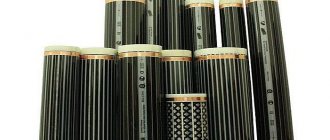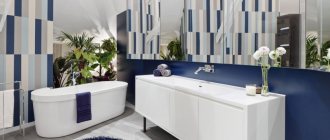Home » Equipment » Warm floor
Most people are increasingly thinking about equipping their home with a variety of heating systems. Some people use superficial methods, such as insulating individual sections of the floor, walls, etc., while others decide to completely renew the floor.
They replace old components with new materials, simultaneously installing water and electrical systems. However, not everyone takes into account that these systems have many positive and negative sides. Warm floors, pros and cons - this will be discussed in this article.
Advantages of heated floors
Convenience and aesthetics:
- the circuit temperature can be easily adjusted, creating a favorable atmosphere and comfort in the room;
- the floor does not overheat and is not excessively cold, the circuit evenly heats all areas of the room;
- the entire structure is hidden under a layer of screed and there are no visible parts on the surface;
- Heat transfer works on the principle of radiation. The accumulated heat is transferred from particle to particle. Convection radiation is minimized as much as possible, and accounts for about 10% of the entire system.
Versatility:
- the system is combined with all kinds of heaters and floor coverings;
- the design can be based on any coolant;
- When choosing floor coverings such as linoleum, parquet, laminate and the like, keep in mind that you need to find out from the manufacturers whether it is possible to combine them with the system that you have chosen. Some finishes are not compatible with electric/water heating systems.
We recommend: How to fill a heated floor?
Environmental friendliness and safety:
- uniform heat flows eliminate the circulation of dust in the room;
- absence of electric magnetic waves due to the fact that the design is based on the contour of the pipes, and not electrical elements.
Efficient Energy Consumption:
- a significant plus is the maximum possible heating of the system to 45-50 degrees. But this is a conditional value; in practice, this parameter does not exceed 30-40 degrees. Because of this undemanding nature, the system is very energy efficient;
- the circuit evenly heats the entire space, but closer to the ceiling the temperature drops by 1-3 degrees. A person does not feel this, and the floor saves up to 20% of electricity. This applies to ordinary rooms with a height of up to 3 meters. However, in enterprises, factories and public places, where the ceiling height is 3 times higher, savings reach 35-45%. Also, taking into account the fact that the heating period lasts on average 200 days, the savings are most noticeable.
But, despite all this, the water heating circuit is quite expensive financially. The complete assembly of the system will cost a pretty penny, even without taking into account the fact that you will involve a specialist.
However, it is worth understanding that you are investing in the long term, since the system, without exaggeration, will serve for decades.
Pros and cons of electric heated floors
Electric heated floors, unlike water ones, have several implementation options:
- cable,
- film,
- mats.
And accordingly, each of them has its own advantages over the others, as well as its own disadvantages.
Cable floor
This type of electric heating system is considered one of the most popular and quite budget-friendly. It consists of special, heat-resistant cables that heat up when exposed to a small current and transfer heat to the floor covering. Like water floors, this type is laid in a screed, which can create some difficulties during turnkey repairs already completed.
The main disadvantage is that if the cable is damaged during operation, then the entire section will have to be replaced; also, few people will like the option that the floors can be used only two weeks after installation.
Heating mats
Formally, these are the same heating cables, simply laid out in a “snake” at the factory and sealed in a special fabric. As a result, their installation is simplified several times. There is no need to make a screed; the mats are placed on a special glue. The only thing is that additional grooves are made on the existing concrete field for better adhesion of the glue and the canvas.
And this type has the same drawback as the previous one - if the sensor fails or a small area is damaged, you will have to re-cover the entire floor or forget about what it’s like to feel warm on your feet.
Infrared film
Of all the underfloor heating options, infrared is one of the most effective ways to heat a room. When using such a film, it seems that the temperature in the room is higher than the thermometer shows. And many will also appreciate the fact that such a system can be installed not only in the floor, but also in the walls, and even in the ceiling, which seriously expands the horizons of creating a warm and cozy home.
It is also difficult to find any disadvantages - this system is installed in one day, you can use all its heating resources immediately after installation, if one of the sections fails, you do not need to change the entire section, but simply replace the broken one and start enjoying the warmth again.
Cons of a warm water floor
Long heating and cooling
The system cools down quite slowly, unlike its electrical counterparts. Possible solution: installing automation to the pipe circuit will help you quickly adjust the required temperature.
Limited heating area
The further the pipes are stretched from the heat source, the cooler the coolant in them. So, in the farthest rooms the temperature will be much lower. This problem can be solved with the help of additional heating devices or by installing a heating system in the walls.
Network dependency
If there is a sudden power outage, the heating will stop functioning. This has a particularly serious impact on those who own homes in harsh, cold climates.
We recommend: How to install electric heated floors under tiles?
Lack of heated air circulation.
If the windows are located higher than 200 cm from the floor, they will periodically fog up, and if they are opened for ventilation, the structure will barely cope with heating the room.
Using air exhaust manifolds will help deal with this situation.
Some disadvantages are so insignificant that they should not be taken into account. In any case, the water heating system has been, remains and will be the most popular in private homes.
Positive qualities of warm electric floors
Warm electric floors can be used not only in apartments and private houses, but also in offices. They go well with almost all floor coverings, including ceramic tiles, linoleum, laminate and other floors. Hidden installation technology allows you to hide the entire system and not spoil the interiors of the premises.
The set of heated floors must include a thermostat that allows you to adjust the temperature with an accuracy of 0.1 degrees. This device can turn heating elements on and off at precisely specified times. The power of the underfloor heating system allows them to be used not only as auxiliary, but also as main heating.
Laying heated floors under ceramic tiles does not require special knowledge or practical skills. Other advantages include uniform heating of the surface over the entire floor area. The entire system can function normally without installing additional equipment, unlike other types of heating using gas or electric boilers.
In case of any breakdown, it is quite easy to determine. The safe operation of heated electric floors is of great importance due to the relatively low temperature of the heating element. All these advantages allow these systems to successfully compete with other types of heating.
Cable heated floor
Cable flooring is most often installed in bathrooms and kitchens, both in private homes and apartments. Cables are divided into:
Single-core
Cables of this type are inexpensive, highly efficient, compared to two-core cables, and do not require electricity.
Twin-core
There is no harmful radiation due to special layers, installation is much easier than with a single-core one.
A common disadvantage of resistive cables is that they cannot be laid under furniture and household appliances, due to possible overheating.
Self-regulating
Pros:
- independently regulate the heating temperature;
- are not susceptible to mechanical damage;
- does not overheat due to automatic regulation;
- long service life;
- simple installation;
- It is allowed to be placed under large furniture.
Minuses:
- high price;
- the system requires a set of ballasts;
- alone cannot warm up the entire room, only the floor.
Disadvantages and advantages of water heated floors
A water heated floor is a pipeline with a heated liquid moving inside. Hot water comes from the heating system or boiler and warms the floor surface.
After cooling, it returns to the boiler through the return line for heating, and the process is repeated again. More often, a circulation pump is responsible for the movement of the coolant, and regulation is carried out using an equipped collector unit.
The “pie” of a water structure consists of a subfloor, a layer of hydro- and thermal insulation, a pipeline, a concrete screed and a finishing coating. Pipes for heated floors are used from various materials: copper, metal-plastic, polypropylene and cross-linked polyethylene.
For your information! Laying in a flat manner is possible, without pouring concrete.
This method is used in the presence of wooden floors that cannot withstand the weight of the screed.
What are the advantages of water heated floors? They are:
- provide uniform heating of the room;
- require little cost to use;
- are installed over the entire area, there is no risk that overheating will occur under large-sized furniture;
- maintain air humidity at a comfortable level;
- hidden under the flooring, do not spoil the design of the room;
- have a long service life;
- economical to operate;
- do not emit electromagnetic waves, therefore completely safe for humans.
It is worth noting that this type of flooring also has disadvantages:
- labor-intensive and time-consuming installation;
- reduce the height of ceilings, as they are often laid under a concrete screed;
- require significant financial investments during construction;
- have difficulties when carrying out repair work, because it is necessary to dismantle the concrete layer.
Water heating is recommended for private houses; they are rarely installed in high-rise apartments, since the main disadvantage is the danger of flooding the neighbors below. In addition, special permission is required to connect to a common heating system.
This device can act as a main or additional heating source. The peculiarity of such a system is the ability to use not only water as a coolant, but also special non-freezing liquids.
For your information! The temperature of the warm hydrofloor coolant should not exceed 45 degrees, and the water in the central heating radiators ranges from 70 to 90 degrees, so it is necessary to install a mixing unit.
Cable mats
Advantages of heated floors:
- Ideal for tiles and any type of floor covering;
- simple installation;
- parts of the system are independent of each other (if a section fails, the system will not fail completely).
The disadvantage of mats is their high cost, especially for mats with a two-core cable.
Manufacturers install both single-core and double-core cables. When choosing, keep in mind that a two-wire one will be more efficient.
Infrared film floors
The system is based on a carbon layer that covers the film. On the sides the sheets are framed with a copper busbar. It works on the principle of heating a carbon layer with electricity, followed by heat release to the external environment.
We recommend: Should I use penoplex for heated floors?
General advantages:
- resistant to sudden temperature changes;
- IR film heats up quickly.
The downside is the rapid cooling of both film and rod sheets.
Infrared film floors
Infrared floors are divided into…
Film:
- the system is quick and easy to install;
- during dismantling, it is possible to reuse the removed structure;
- if a separate part of the system breaks down, the entire circuit will not stop functioning, since the parts are not interconnected and do not depend on each other;
- The film can be easily divided into parts of the required sizes for ease of installation, both in small passages and in large rooms.
Minuses:
- You need to choose your flooring wisely, as it may be too thin or too thick. In the first case, it may be deformed, in the second, the heating efficiency will be reduced;
- The heated floor must be laid on a completely dry surface.
Rod:
- automatic increase and decrease in energy efficiency due to increased or decreased ambient temperature;
- Laying under large pieces of furniture is permitted. Overheating is excluded;
- even if two or more parts fail, the system will function properly.
Disadvantage: mats cannot be combined with a foil backing, since due to the interaction of individual elements, both the film and the backing will be deformed.
Recommendations
When choosing a heated floor, take into account the functional features of the system. Also be interested in the possibility of combining heated floors with other building materials.
The advantages of heated floors often come with many disadvantages, so be careful. And no matter what floor you want, purchase products only from trusted manufacturers.
- Related Posts
- How are PEX pipes connected for heated floors?
- How to lay cable heated flooring?
- How to make a warm floor from a heated towel rail?
- What is a warm floor National Comfort?
- What should be the height of the heated floor?
- How to design a heated floor?

